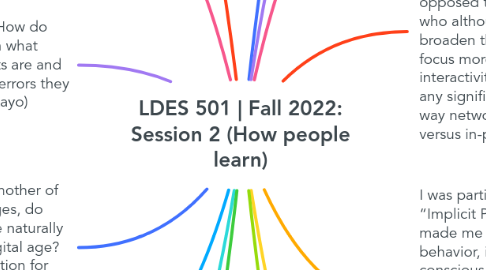LDES 501 | Fall 2022: Session 2 (How people learn)
by Yianna Vovides

1. The biggest question I've ever had while studying Connectivism is, if students want to learn at their own pace, how should I evaluate it? (Won)
1.1. As previously said, connectivism is learning by interacting with others through networks, and some people may prefer to study independently and at their own pace due to personal characteristics. In this situation, educators should consider how to plan for evaluation and assessment.
2. How do you scale that? Say you have a class for 100 students from various cultural backgrounds; how are you able to not only check for the different nuances they would bring into the classroom but also make room for that nuance? (Fikayo)
2.1. Africa is a huge continent and surely the way people learn across the continent would differ from country to country and even more specifically, from household to household. Which leads me to another question I have about accounting for cultural differences when designing learning experiences.
3. How do you solve this? How do you check in a classroom what people's cultural contexts are and then make room for the errors they will inevitably make? (Fikayo)
3.1. In chapter 3, the authors of How people learn talk about different learning models and while discussing learning by inference, they make this point “...Learners and instructors may not recognize the extent to which their models are not shared”
4. With English being the mother of all major coding languages, do non-English speakers are naturally disadvantaged in the digital age? Is bilingual design a solution for early learners for Chinese speakers? (Paul)
5. What really is the role of neuroscience in informing education? (Danny)
6. I enjoyed reading about Connectivism and thought it was a compelling theory for learning in our modern world. However, I found myself wondering what the negative effects of relying on technology for our information may be? (Danny)
7. Does human instinct, the way of reacting to something count as the knowledge that we were born with, or is it something that we create based on our experience? (Odmaa)
8. What would it look like, in practice, to combine learning theories in an assignment or engagement? (Hannah)
8.1. Ample research would need to be done before the design – understanding the audience, understanding the goals, and figuring out how to measure learning along the way (connection with learning analytics).
9. How do we approach what we don’t know about the brain? (Hannah)
9.1. Something that stood out to me is that there are still questions.
10. How can the instructional design accommodate for the individualized nature of learning in traditional group settings of classrooms? (Aakansha)
11. The online modality of eLearning places emphasis on the use of technology for knowledge retrieval and connection forming as opposed to traditional learners who although use technology to broaden their knowledge, might focus more on in-person, social interactivity. Would there then be any significant differences in the way networks are built online versus in-person? (Aakansha)
12. I was particularly intrigued by “Implicit Pattern Learning.” First, it made me think about animal behavior, in that it doesn’t require conscious attention and reflection. Is there benefit in understanding how animals learn when it comes to considering how humans learn? I’m thinking of how powerful the limbic system (“lizard brain”) is in driving motivation across species. Is there some corollary to this when it comes to learning? (Salvo)
13. Thinking not about other animals but about machines, do they also learn implicit patterns? Is this the basis of machine learning? And similarly, how can our understanding of how machines learn affect how people learn? (Salvo)
14. How do we keep our research current and continue to adjust as we learn more about the science? (Hannah)
14.1. These are both open-ended questions, but I’m thinking of shifting a disposition to make current research central to my project as a designer.


